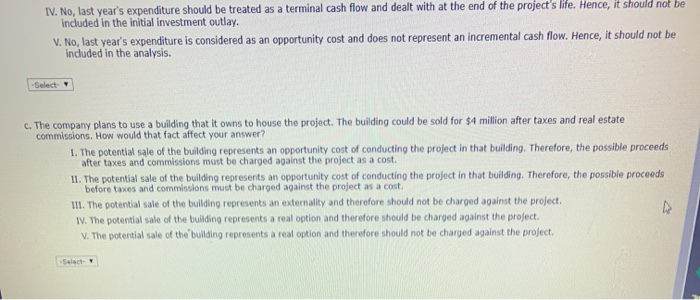ick here to read the eBook: Analysis of an Expansion Project EQUIRED INVESTMENT Tannen Industries is considering an expansion. The necessary equipment would be purchased for $10 million, and the expansion would require an additional $4 million investment in net operating working capital. The tax rate is 40%. a. What is the initial investment outlay? Round your answer to the nearest dollar. Write out your answer completely. For example, 13 million should be entered as 13,000,000. b. The company spent and expensed $10,000 on research related to the project last year. Would this change your answer? Why? 1. No, last year's expenditure is considered a sunk cost and does not represent an incremental cash flow. Hence, it should not be included in the analysis 11. Yes, the cost of research is an incremental cash flow and should be included in the analysis, III. Yes, but only the tax effect of the research expenses should be included in the analysis. IV. No, last year's expenditure should be treated as a terminal cash flow and dealt with at the end of the project's life. Hence, it should not be included in the initial investment outlay. V. No, last year's expenditure is considered as an opportunity cost and does not represent an incremental cash flow. Hence, it should not be Included in the analysis. -Select- IV. No, last year's expenditure should be treated as a terminal cash flow and dealt with at the end of the project's life. Hence, it should not be included in the initial investment outlay. V. No, last year's expenditure is considered as an opportunity cost and does not represent an incremental cash flow. Hence, it should not be included in the analysis. -Select c. The company plans to use a building that it owns to house the project. The building could be sold for $4 million after taxes and real estate commissions. How would that fact affect your answer? 1. The potential sale of the building represents an opportunity cost of conducting the project in that building. Therefore, the possible proceeds after taxes and commissions must be charged against the project as a cost. II. The potential sale of the building represents an opportunity cost of conducting the project in that building. Therefore, the possible proceeds before taxes and commissions must be charged against the project as a cost. III. The potential sale of the building represents an externality and therefore should not be charged against the project. IV. The potential sale of the building represents a real option and therefore should be charged against the project. V. The potential sale of the building represents a real option and therefore should not be charged against the project








